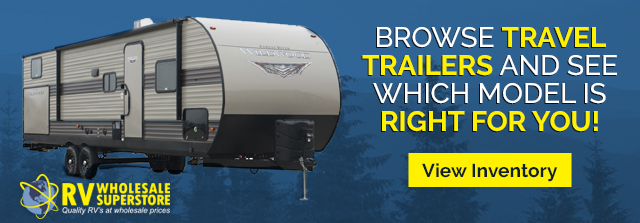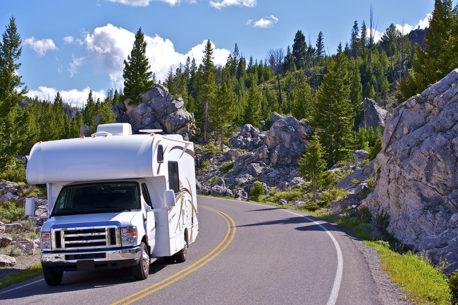Memories are some of the best things you make when you’re RVing. Chances are, you’ll make some dirty clothes, too! Whether you’re a weekend warrior or living the RV life full-time, it’s a given that you will end up with some laundry to do. What’s the best way to handle RV laundry? Depending on the duration of your trip and the amount of clothes you need to launder, there are several options that can keep your clothes from getting a little too “campy.”
RV with Washer & Dryer
Ideally, RV laundry can be done right in your RV if you have a washer and dryer with you. Many RVs come equipped with washer and dryer, or hookups for them. Living the RV life can certainly feel like home when you are only a few steps from the laundry facility.
Keep in mind that the capacity of small RV laundry appliances tends to be much lower than full-size models. Planning one or two small loads a day can help you keep up with dirty clothes – especially if you have children. When you are living the RV life full-time it helps keep the small space tidy. If you are just taking short trips, you won’t have a mountain to wash when you return home.
The convenience of laundry at your fingertips means you can pack fewer items of clothing knowing that you can do laundry whenever the need arises. It’s also a great way to ensure there’s always dry towels for swimming – a must when camping near lakes, rivers, water parks, or the ocean.
If you prefer camping in remote locations where electrical and water hookups may not be readily available, then RV laundry appliances may not be as much of a high priority. The good news is there are plenty of alternatives.
Campsite Laundromat
Many campgrounds have laundry facilities on site. You can do research ahead of time and see if a laundromat is mentioned on the campground’s website. Knowing whether laundry services are available where you’ll be staying is a great way to plan ahead when you are packing. If you know that you’ll have access to washers and dryers, you can pack lighter and save space.
Campground laundry facilities can be a good compromise between having RV laundry and going to a laundromat. They give you the convenience of having laundry close by but eliminate the need for keeping a washer/dryer combo in your RV. They also provide larger “home-sized” machines, so you can wash a lot more in one load than the smaller RV laundry models. Just like campground etiquette, be sure to practice laundromat etiquette. Leaving laundry unattended or washing heavily soiled items that may leave residue behind are practices to avoid.
When there’s no laundromat at your campground, you’ll need to find other laundry options if you know you’ll run out of clean clothes or towels before the end of your stay.
Local City Laundromat
When there aren’t washers and dryers at your campground, the next best thing is a laundromat in the nearest city. Depending on how remotely you are camping, it could be quite a drive. So, if you know you’ll be needing to take a long trip for laundry, you can plan it mid-stay and make a day of it. Stock up on any groceries or other needs while you’re in town. Maybe even catch a movie or find out if there are any local areas of interest to explore.
Some laundromats have drop-off service. If you’re on a busy schedule, or wanted to make a day of sightseeing, dropping off your laundry to be completed and ready for your return is a great option.
Most laundromats are similar no matter the town, though they may differ in their level of modernness. You may find state-of-the art new washers and dryers or it may feel like you’ve taken a step back in time. If you forget your quarters, many laundromats are upgrading to new equipment that accepts credit cards. Some even offer free WiFi, Cable TV, and charging stations for phones, tablets and laptops! This can really be a goldmine if you’re remote camping and want to save on batteries. But at the very least, the laundromat is a means to clean laundry.
Handwashing & Line Drying
Believe it or not, there weren’t always appliances for cleaning clothes. In fact, you don’t even need them! Washing clothes by hand and line drying them is quick and easy when you only have a few lightly soiled items and is a great solution in a pinch or when boondocking. All you need is a tub, water and soap.
For heavier soil you may need some tools to help scrub out the dirt. There are many inexpensive options from small hand-held plastic washboards to washtub/washboard combination tools. A laundry line or bungee cord can be strung up between trees, between a tree and your RV, or even secured between your RV and your RV toad if you have one. Just add clothespins!
Portable Washer & Dryer
If scrubbing clothes isn’t your ideal solution for RV laundry, a portable washer/dryer combo might be the perfect solution for you even if your RV doesn’t have hookups. These little combo appliances only handle small loads of laundry, but if you want an automatic process in a small space, it could be just the ticket – and save you a trip to the laundromat.
Packing Extra Clothes
The final solution is the obvious one – pack more clothes! You’ll avoid laundry altogether giving you more time to enjoy your vacation. It’s a great solution if you aren’t doing full time RV living. Simply make sure you have the room to pack (or overpack) your outfits and that you don’t mind spending the time playing catch-up with your laundry when you get home.
If the pack now, wash later option is your RV laundry solution of choice, it’s important to plan ahead when packing. There are loads of situations that can make the dirty clothes pile up quickly! Watch the weather for rain which can cause muddy terrain and call for frequent clothing changes. Hiking, boating, or swimming can also add to the need for extra clothes.
Be as generous as space allows with your overpacking if you plan to forgo any RV laundry options. That way the memories you make on your trip won’t consist of stories like, “Remember the time Uncle Mike had to wear muddy pants all weekend and Aunt Suzie wouldn’t let him in the camper?”

Contact RV Wholesale Superstore
The professionals at RV Wholesale Superstore are ready to help you find the perfect RV for you and your family. Visit us in-person at 5080 W. Alexis Road, in Sylvania, OH or call us at (419) 786-1126
Connect with us on Social Media!



